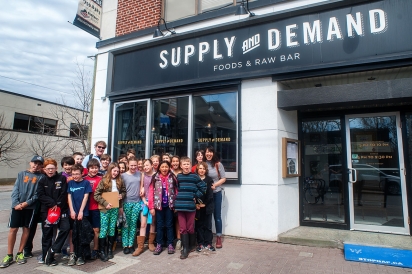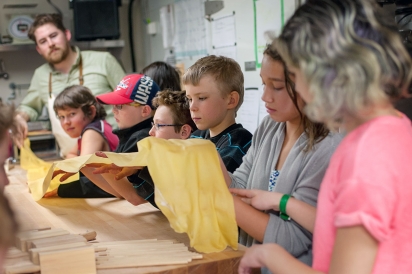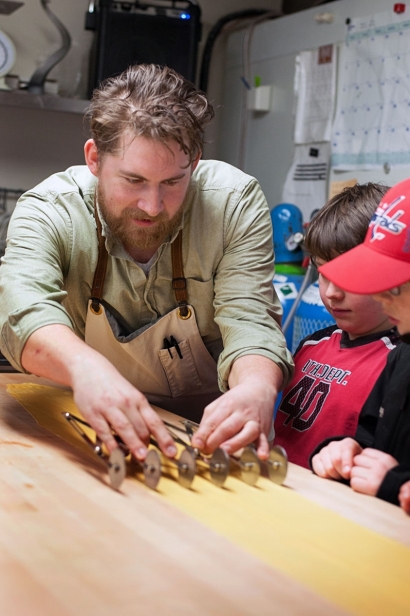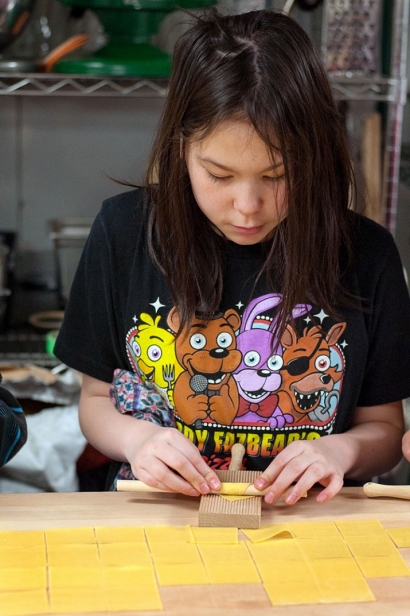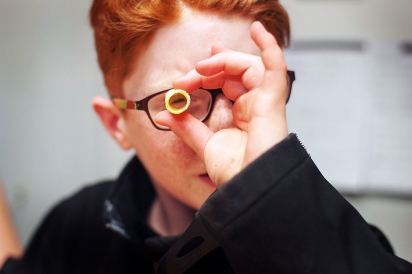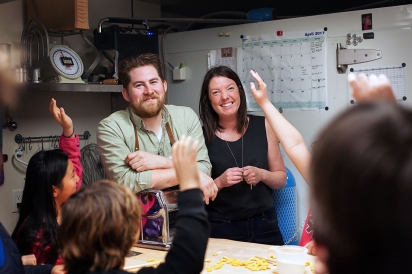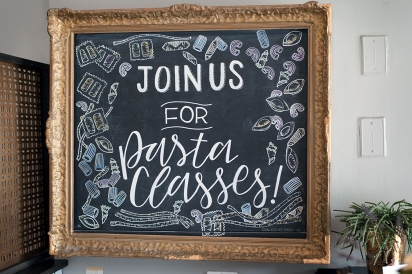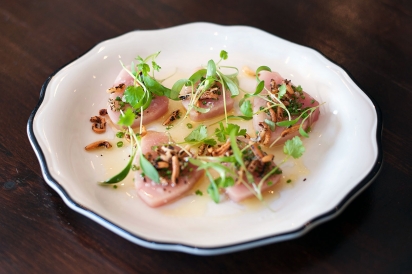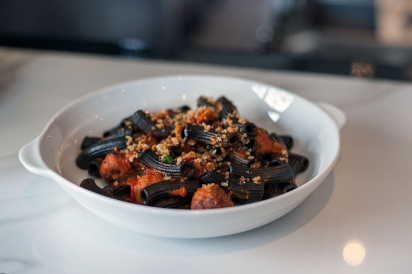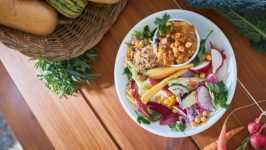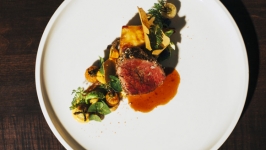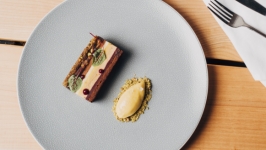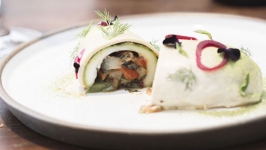Pasta Math
Did you know that the trick to making good pasta is surprisingly mathematical? While fresh pasta has only a few ingredients — flour, eggs and water in different combinations — it’s the ratios and the humidity that are important to success.
Pasta, from start to finish, is a good mathematical exercise. Not only is success predicated upon getting the right ratio of ingredients and the correct levels of humidity, which change seasonally (52 per cent in summer, 58 per cent in winter), but it’s also about working out just how much dough you need to feed that night's dinner guests.
For the Churchill Alternative Public School's Grade 5/6 class, a visit to Supply and Demand restaurant on Wellington Street West, was a great chance to see the inner workings of a small high-quality restaurant and a chance to apply their classroom math skills to a real-life work assignment.
Chef and co-owner Steve Wall gathered 24 excited children in his basement pasta kitchen. It was a tight squeeze, but the students assembled around the wood and stainless steel worktop and asked plenty of intelligent questions.
“How do you make all the different kinds of pasta?” asks one boy as Chef Wall put a ball of dough through a pasta machine, producing a wide, flat and almost translucent sheet of pasta that’s about 15 feet long. “Most kinds of pasta come from one of two doughs,” Wall explains, “one made with eggs and flour, the other made with flour and water. But they are simply shaped in different ways.”
“How much pasta do you need to feed one person?” asks another student. “We give each person 24 garganelli tubes per order,” explains Wall, while distributing wooden dowels and a ridged wooden block, (a gnocchi paddle) to each student, “and each ball of dough is enough for about 15 people.”
Wall first cut the pasta into wide ribbons, then into small squares using an instrument that resembles a simple combine. He distributed these to the students and showed them how to shape garganelli by wrapping a square around a dowel and running it down the ridged block. The students slid their finished pieces carefully into a pile. “On a busy night, about 80 per cent of customers will order pasta and we’ll serve 40 portions of pasta a night,” Wall says. That’s 960 garganelli, for anyone needing help with quick mental arithmetic.
Some pasta shapes just cannot be made by hand, so Wall has an extruder. It looks like a Play-Doh machine and has any number of dies, which make varying shapes of pasta. For this, he generally uses 100 per cent durum semolina flour and water; it’s a high protein flour so doesn’t need the addition of eggs. “We make rigatoni, bucatini, thicker spaghetti and others from the classic range, as well as just what we feel like making,” Wall says.
Once shaped, the handmade pasta is dusted with semolina flour and left out to dry for 10 minutes, before being bagged and stored in a fridge until cooking. Pasta shaped using the extruder has lower humidity levels and therefore doesn’t require the drying time.
“How long do you cook it for?” a student asks. Here, Wall comes back to the question of humidity. Since fresh handmade pasta has a much higher humidity level, somewhere close to 58 per cent, he explains, it doesn’t need to cook for so long — a minute and a half should do it. Dried pasta, which typically has a humidity level of 12 per cent to 13 per cent, cooks for eight to 10 minutes.
“We’ve started to get more into the science of pasta-making in the last few years,” Wall says. “Salt, for example, enhances the gluten in pasta. So we took it out and it made the dough more tender. It makes for a more delicate feel in the mouth.”
Supply and Demand bills itself as a “foods and raw bar.” It’s known across the city for possibly the best tuna crudo in the business. On TripAdvisor, one writer after another, gushes about this dish. It’s a home run of raw fish, served with truffle oil, puffed wild rice, a few green cilantro sprouts and Maldon salt crystals. While delicious, this luxurious dish also provides a small-scale example of how to run an efficient restaurant by respecting ingredients and using them to the fullest.
Once the prime loin has been served as tuna crudo, Wall saves any scraps of fish for another menu staple, the squid ink rigatoni, with tuna and prosciutto meatballs. Served with a rich tomato sauce, it’s a great way to use up prosciutto ends and tiny pieces of fish, truly eating snout to tail.
The economics of running any small restaurant are precarious. Pasta is a relatively inexpensive raw ingredient, but most proteins are not. Wall takes great care in the design of his menu to reduce food waste and use every bit of the produce that he buys. And that includes stale bread, which he freezes and uses for breadcrumbs.
“We try to be as creative as possible with all the ends,” Wall says. “We really try to challenge ourselves. It’s the way you have to cook to be responsible with the products coming through your door.” Recent examples include scraps of leftover cod that Wall salted, then dried to produce a whipped salt cod brandade with mamorille cheese, shishito peppers and grilled bread, as well as potato gnocchi bolognese, the rich, meaty filling made from the offcut of meat.
Wall and his team also cure their own meat in-house. Shoulders and legs of pork hang curing in a temperature-controlled room, while salami sausages dangle like Christmas decorations from strings alongside. For each kilogram of weight, a leg of pork must sit on a bed of kosher salt for four days.
Back to the basement pasta kitchen: ”How do you make pasta sauce?” asks a student. “Sauce comes in so many different ways,” Wall explains. “Simple is always good, like tomato sauce and meatballs, but we also make sauces using chicken stock, shrimp stock, shaved garlic, white wine, olive oil and cheese rinds. There are many layers to good sauces and they all stick to the different pastas in different ways.”
“What do you like in a customer?” asks another student. “Somebody who comes back regularly,” replies Jen Wall, Chef Wall’s wife, co-owner and business partner. “But in all honesty, our goal is that every person who leaves has had a great experience.”
Supply and Demand Foods & Raw Bar
1335 Wellington St., W., Ottawa, Ont.
supplyanddemandfoods.ca, 613.680.2949



